Keys to Cheyletiella and Walking Dandruff in Dogs
Remember, this is an educational resource, not a guide for diagnosis.
Pictures are helpful, but they may not tell the whole dermatological story. We always recommend consulting with your vet for any of your dog's health concerns.
🎄 25% Off 🎄 Christmas Countdown Sale
Use code FELIZNAUGHTYDOG at checkout and get your dog, grand-dog, or your friend's dog the gift of relief!
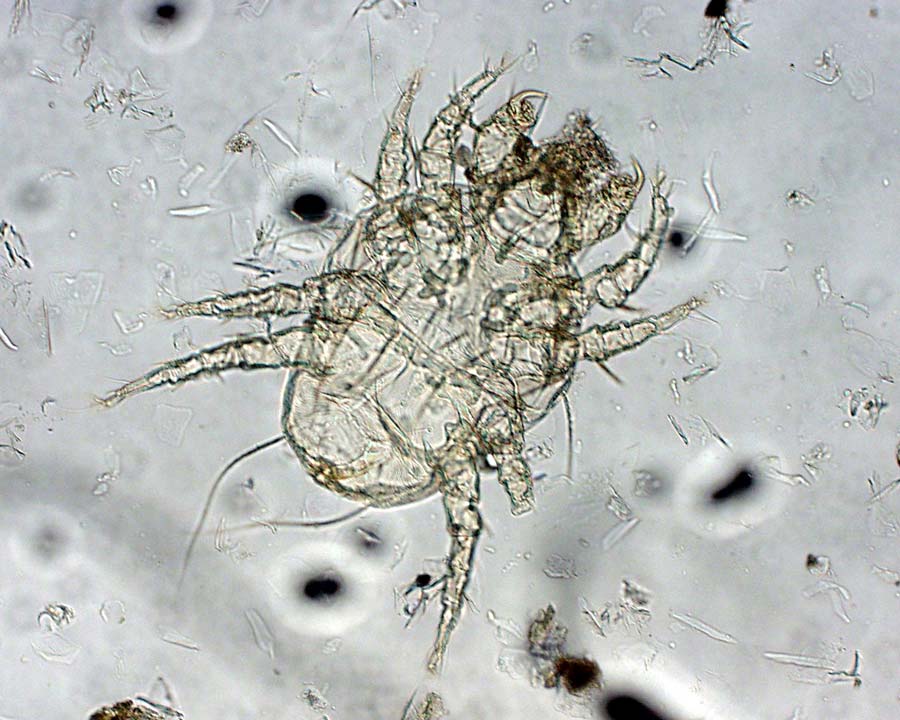
What is Walking Dandruff (Cheyletiella) in Dogs?
Walking dandruff, formally known as cheyletiella (pronounced "ki-la-tee-el-a") or cheyletiellosis, is a highly contagious, zoonotic skin disease in dogs that is caused by an infestation of mites of the Cheyletiella species, especially Cheyletiella yasguri. These mites live on hair follicles and feed on epithelial debris.
Cheyletiellosis gets its nickname "walking dandruff" from two factors: (1) The large, often white-colored mites resemble flakes of skin and can sometimes be seen moving across the skin and fur; (2) the infestation causes an excessive amount of scaling skin (dandruff).
Photo: Cheyletiella yasguri mite under microscope; via Kansas State School of Parasitology
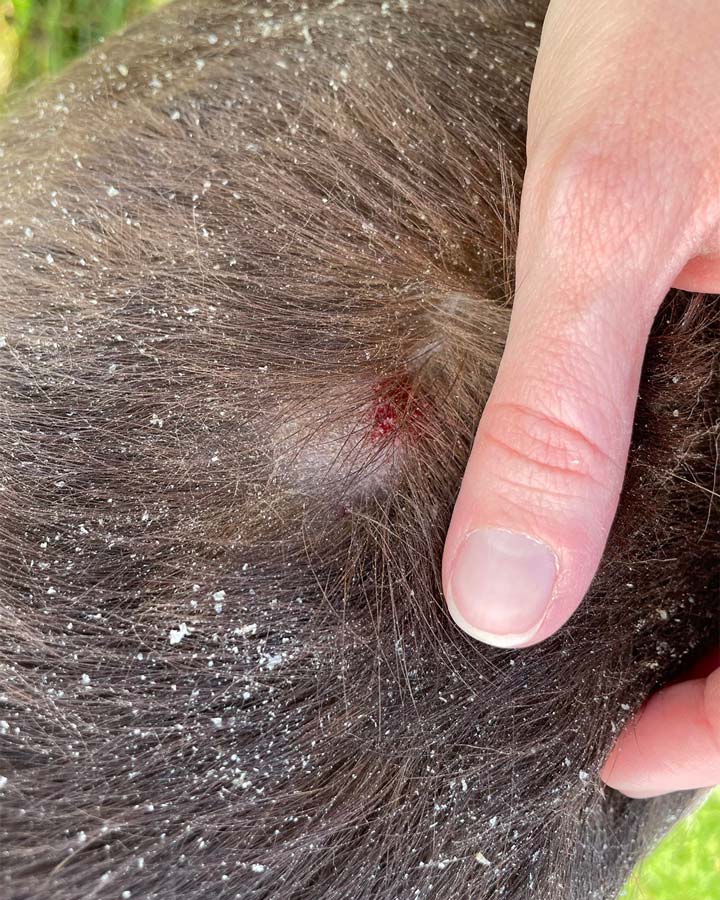
What Does Walking Dandruff (Cheyletiellosis) Look Like on Dogs?
Walking dandruff causes massive amounts of scaling skin, especially on the dog's back and upper body, with large, noticeable flakes. Overall, it tends to resemble a flurry of snow atop a dry, lackluster coat.
Itching (pruritus) is common, ranging from mild to severe. However, this can depend on the dog, as some dogs may experience little to no itching as they harbor the mites. Excessive scratching and rubbing can lead to fur loss, open sores, and hot spots.
It should be noted that any form of parasitic infestation puts a strain on the immune system and can weaken it. Weakened and compromised immune systems pave the way for bacterial (pyoderma) and yeast (Malassezia) infections to establish and create a much bigger problem.
Photo: Severe dandruff and dry skin on labrador, possibly due to Cheyletiella mite infestation, with sore due to itching; via r/layla347 on Reddit
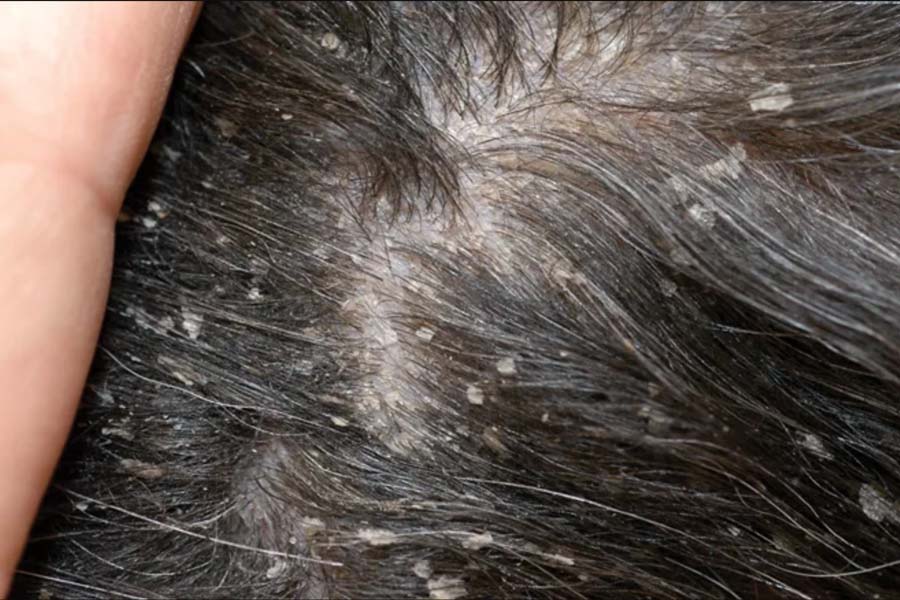
How Do Dogs Get Walking Dandruff?
Dogs get walking dandruff as the Cheyletiella mites are transmitted via direct contact with other infested animals, which can include other dogs, cats, rabbits, and even humans. The mites can also survive off-host for up to 10 days on surfaces that the infected animal has touched.
Environments such as dog parks, kennels, shelters, and groomers are possible locations where Cheyletiella can be spread among dogs.
On animals, the mites have a life cycle of 21 days that is perpetuated until the infection is eliminated. On humans (thankfully), the mites cannot complete their life cycle, but they can cause itchy red bumps resembling flea bites for a short time.
Photo: Cheyletiellosis (walking dandruff) on Scottish terrier, by J.O. Noxon, DVM, DACVIM of Iowa State University; via Clinician's Brief
Key Symptoms of Walking Dandruff
- Excessive dandruff and widespread skin scaling, typically on the back
- Big flakes of skin, which may appear to be moving when closely observed
- Mild to severe itching, though not in all cases
- Excessively dry skin and lackluster coat
In severe cases:
- Hair loss (alopecia)
- Wounds from scratching
- Seborrheic dermatitis, from issues with sebum glands on hair follicles
- Hot spots (acute moist dermatitis)
- Secondary bacterial infection (pyoderma)
- Secondary fungal yeast infection (Malassezia)
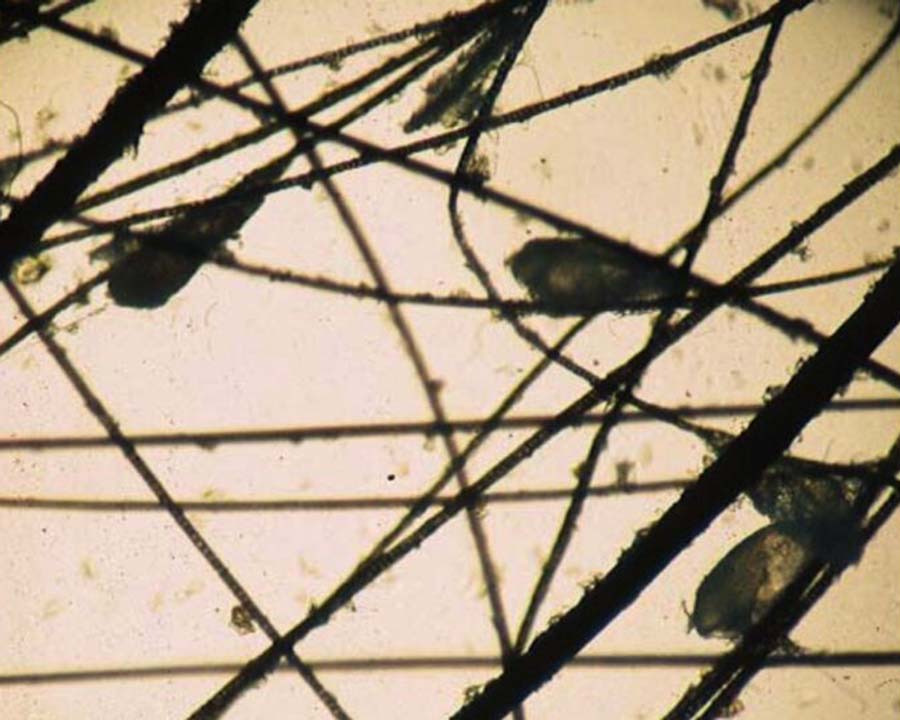
How is Walking Dandruff (Cheyletiellosis) Diagnosed?
Diagnosis of cheyletiellosis (walking dandruff) considers the clinical signs and identification of the mites under a microscope after taking skin scrapings.
While uncommon, Cheyletiella mites can "hide" and evade attempts to harvest the mites for microscopic analysis. This ability is shared by sarcoptic mange mites (scabies), a far more serious parasitic infestation.
When an initial diagnosis of cheyletiella cannot be obtained due to a successful "hide-and-seek" campaign, a positive response to known parasitic mite treatments can retroactively confirm cases of walking dandruff.
Photo: Microscopic view of Cheyletiella mite eggs attached to hairs; via Veterinary Practice
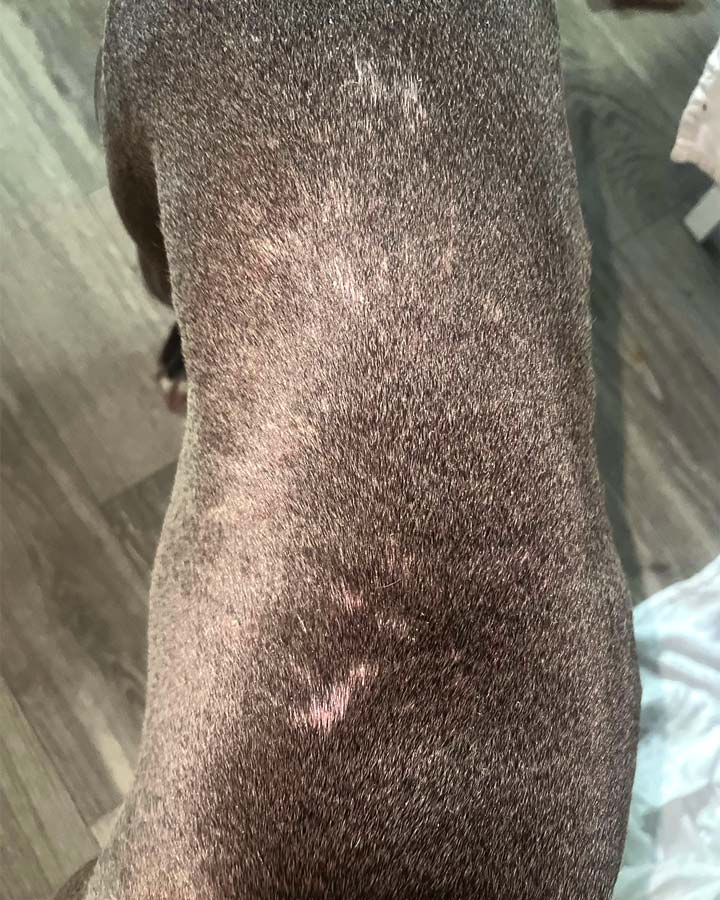
How Is Walking Dandruff in Dogs Treated?
Cheyletiella mites are susceptible to many topical insecticides routinely used for flea and tick control, and treatments can include:
- Medicated baths, such as selenium sulphide shampoo, once per week for 3 weeks
- Lime-sulfur dips - typically administered by veterinarians - applied weekly for 4 weeks
- Topical and systemic medications that contain selamectin, fipronil, ivermectin, and moxidectin
It's a good idea to treat all pets in the household to prevent re-infestation. In addition, clean and sterilize all bedding, carpeting, and other surfaces that the dog has come into contact with, as the mites can survive and potentially spread to other dogs or pets.
Photo: Dog with widespread dandruff and small patches of fur loss, likely due to Cheyletiella; via r/LostExtreme6267 on Reddit
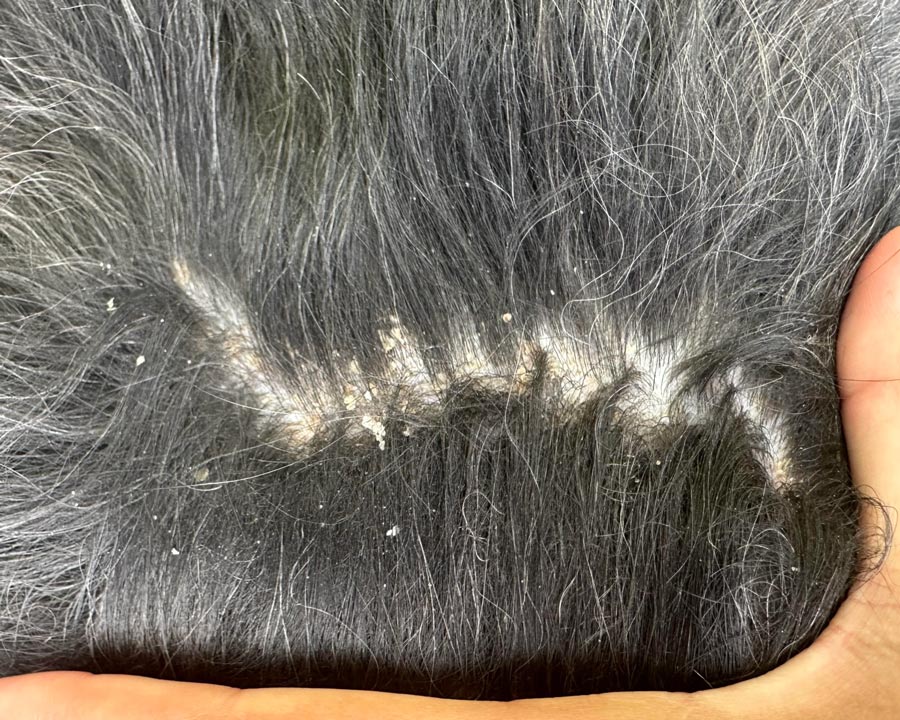
Similar Scaling: Walking Dandruff vs Seborrhea
Another skin condition in dogs that can exhibit flaking crusts of skin is seborrhea, or seborrheic dermatitis.
Seborrhea is a skin disorder that involves an over-production or under-production of keratin, a vital skin protein. Generally, seborrhea creates a keratin buildup on the skin, which resembles yellowish flakes (dandruff) or scales on the skin. These buildups can appear dry or oily.
Unlike walking dandruff, seborrhea is not contagious. Seborrhea typically arises as a secondary disorder, appearing as a result of another skin issue, like an infection, allergies, or parasites, that has disrupted the normal keratin production cycle.
It is possible for a Cheyletiella mite infestation to lead to seborrheic dermatitis. Check out our Seborrhea Resource for more info on this crusty issue.
Walking Dandruff (Cheyletiella) in Dogs FAQs
What causes dandruff on dogs in general?
Poor nutrition (especially lack of necessary Omega-3 fatty acids in the diet), inadequate grooming, prolonged time spent in an arid/indoor environment, seborrhea, demodicosis (demodex mange), pediculosis (lice), or other parasitic infections can lead to dandruff and scaly skin.
How do dogs get walking dandruff?
Walking dandruff, also known as cheyletiellosis, is caused by an infestation of Cheyletiella mites. In dogs, the primary species responsible is Cheyletiella yasguri.
These mites are acquired from other animals that carry them, including other dogs, cats, or rabbits. Surfaces that infected animals have been in contact with can also transmit the Cheyletiella mites.
Lastly, it should be noted that dogs with weak or compromised immune systems will be more susceptible to parasitic infestations and infections in general.
What are the symptoms of cheyletiella (walking dandruff) in dogs?
- Excessive dandruff and widespread scaling, typically on the back
- Large flakes of skin may appear to be moving when closely observed
- Mild to severe itching, though not in all cases
- Very dry skin and lackluster coat
In more severe cases:
- Patches of fur loss (alopecia)
- Open sores from scratching
- Seborrheic dermatitis
- Hot spots (acute moist dermatitis)
- Secondary bacterial infection (pyoderma)
- Secondary fungal yeast infection (Malassezia)
Can a dog die from walking dandruff?
It is extremely unlikely. The Cheyletiella mite infestation itself would not be considered the probable direct cause of death.
It is more likely for a fatal systemic infection (bacterial, fungal, or both) to develop because of, or in addition to, a generalized case of walking dandruff.
How long does it take to get rid of walking dandruff (cheyletiellosis)?
Consistent treatment with approved medications should eliminate the Cheyletiella mite infestation within 4 to 5 weeks. More time may be required to return the skin and coat to normal.
If present, a compounding case of pyoderma (bacterial infection) or a Malassezia yeast infection would call for a longer and more complex treatment plan to clear the infection on top of eradicating the mite population.
Systemic infection is ultimately the biggest and deadliest risk of any dermal parasitic infection.
Do flea and tick products help with walking dandruff?
Some can, yes - though it is considered an off-label use.
Several prescription flea and tick products contain ingredients that are effective at killing and repelling Cheyletiella mites (and also mange mites), such as:
- Selamectin
- Fluralaner (Bravecto®)
- Milbemycin oxime (Interceptor®)
Is walking dandruff (cheyletiella) in dogs contagious?
Walking dandruff is contagious and zoonotic - meaning that it can be spread between dogs, other animals, and humans.
The mites can survive off-host for up to 10 days, so surfaces that an infected animal touches must be cleaned and sterilized to prevent spread.
Thankfully, in humans, the mites cannot complete their life cycle, so the infected is self-resolving. However, they can cause itchy red bumps to form for a brief period.
Is walking dandruff in dogs itchy?
Itching due to walking dandruff can range from mild to severe - depending on the dog.
Though uncommon, some dogs may exhibit little itching and simply act as non-symptomatic carriers of the Cheyletiella mites.
Will my dog's walking dandruff go away on its own?
While it is possible, it is very unlikely.
Once confirmed, it is best to eradicate the infestation before a more serious problem, such as a bacterial and/or yeast infection can occur.
Can Lavengel® help with walking dandruff?
We do not know if Lavengel® is effective against the mites themselves, but we do know it can be invaluable in relieving the itch and irritation caused by mite infestations, helping the damaged skin to heal, and aiding in fur regrowth.
Further, it's great as a potential spot treatment for any sores or infected wounds that have come about due to a dog's scratching.
What's the difference between walking dandruff and mange?
Walking dandruff is caused by Cheyletiella mites, and mange (which comes in two forms) is caused by two different species of mites.
Mange is caused by two different species of parasitic mites, whereas yeast infections are caused by a fungus (Malassezia pachydermatitis). Yeast and mange require very different forms of treatment. You can get a lot more info on the two types of mange on our Yeast Resource Page.
Since both types of conditions - in their severe forms - can result in hair loss, severe itching, hyperpigmentation (dark coloring), and scaly skin, these two conditions are often confused. In fact, a severe mange mite infestation can lead to secondary pyoderma and yeast infections.
It should be noted that, in general, mange is rather uncommon, and occurs much less frequently than yeast dermatitis.
What's the difference between walking dandruff and mange?
Walking dandruff is caused by Cheyletiella mites, and mange (which comes in two forms) is caused by two different species of mites - Demodex and Sarcoptes mites.
Demodex and Cheyletiella mites are found in the same order of classification, and they tend to live on hair follicles. Sarcoptes mites (scabies) live on and burrow into the skin. All three can bring about scaly skin, dandruff, severe itching, and hair loss - with scabies being the worst of the three.
Interestingly, Cheyletiella, Demodex mange, and Sarcoptic mange are all treated using similar methods and medications.
Can humans get walking dandruff from dogs?
Yes, in a sense. Cheyletiella mites can be spread to and from humans. However, the mites cannot complete their life cycle on humans, so they will die off.
Humans may temporarily experience itchy red bumps caused by the mites that look like flea bites, but they will not experience "walking dandruff" - the excessive scaling and dandruff seen in dogs or cats.
Can I see walking dandruff mites on my dog without a microscope?
Adult Cheyletiella mites can grow to 0.5mm in size, which is just visible to the naked eye. That said, for proper diagnosis, mites should be identified under a microscope.
More Canine Skin Woes
-
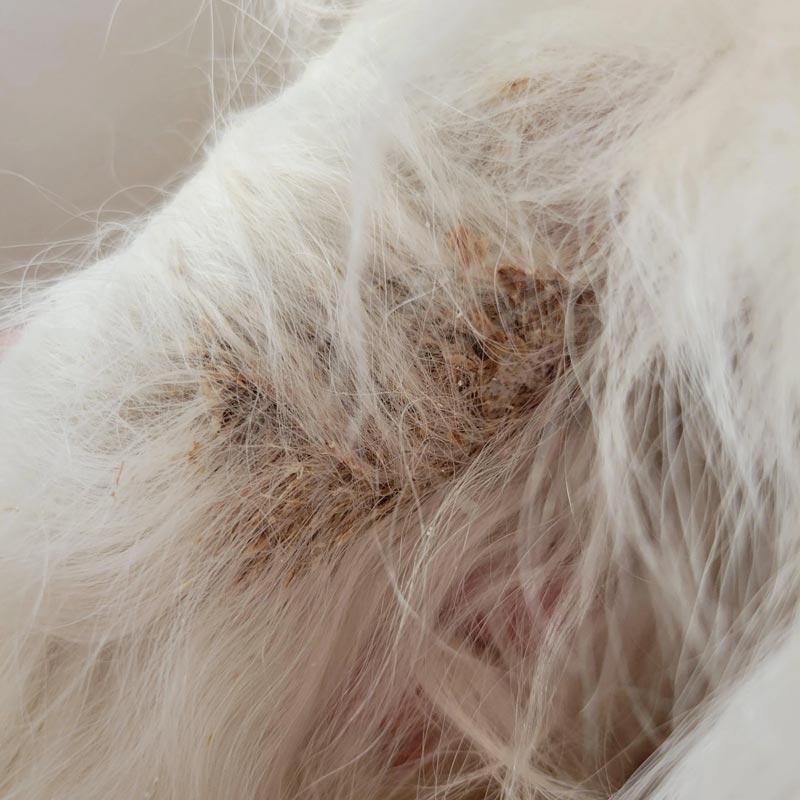
Seborrhea
Don't trust the crustSimilar to walking dandruff, seborrhea involves excess keratin production and buildup on the skin, with thick dandruff and oily crusts.
-
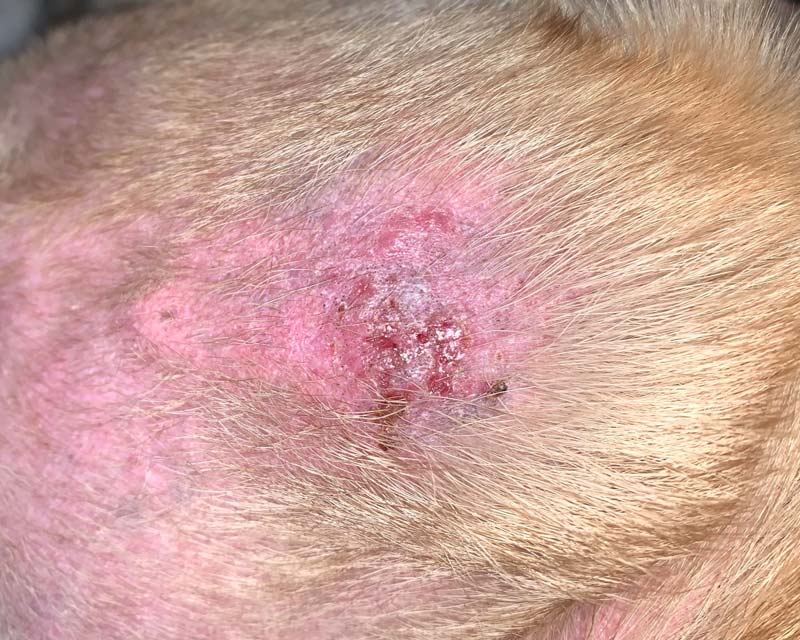
Pyoderma
Time for a Staph meetingPyoderma refers to a bacterial infection of the skin, and it turns out that over 90% of all cases are caused by a single species of bacteria.
-
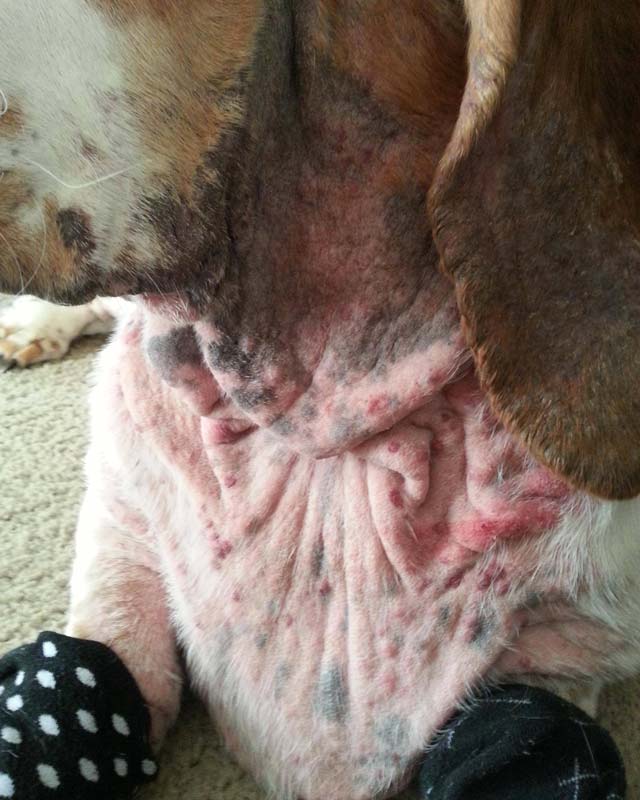
Yeast Infections
Yeast can be a real beastYeast infections can affect the skin (dermatitis), ears (otitis), and paws, and are caused by a fungus called Malassezia.
Collapsible content
Resources on cheyletiellosis (walking dandruff) in dogs
- VCA Animal Hospitals: Cheyletiellosis in Dogs
- MedVet: Cheyletiellosis in Dogs and Cats
- PetMD: Walking Dandruff in Dogs
- Veterinary Practice: Diagnosing and Treating Cheyletiellosis
- Canadian Veterinary Journal: Successful Treatment of 3 Naturally Acquired Cases of Canine Cheyletiellosis with Fluralaner
- University of Saskatchewan, Western College of Veterinary Medicine: Cheyletiella Species
- DVM360: Cheyletiella, The Under-Diagnosed Mite


